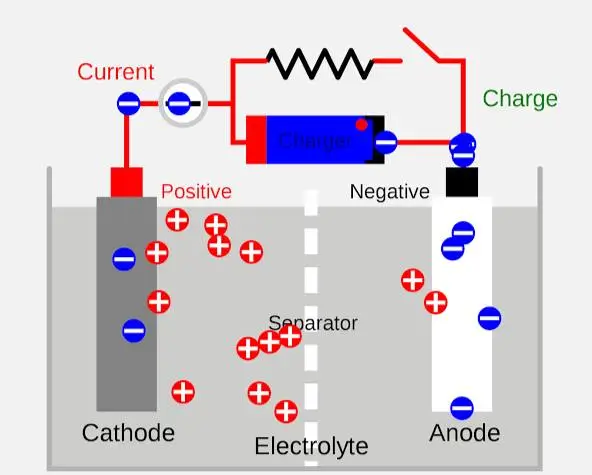Why can’t we store AC in Batteries instead of DC?
Electrical energy is not stored directly in a battery. The battery stores electrical energy in the form of chemical energy.
Imagine that an alternating current (AC) is supplied directly to a rechargeable battery, with the negative terminal of the AC source connected to the negative terminal of the battery and the positive terminal of the AC source connected to the positive terminal of the battery. The current starts flowing. But something goes wrong.
Alternating Current (AC) changes its polarities (i.e. it flows in two directions). That is, in the one-half cycle of the AC waveform, current flows in one direction, but flows in the opposite direction during the other half cycle.
During the positive half cycle of the AC, conventional current flows to the battery through Cathode, and it gets charging. But when the AC gets to the negative half cycle, the current direction reverses, thereby leading to a discharge of the battery. And so on.
In the end, the positive half cycle of the AC that is charging the battery cancels out the negative half cycle that is discharging the battery. So, the battery does not get charged.
In fact, if the Alternating Current (AC) continues to supply the battery, it could damage it.
To prevent the discharge of the battery caused by the negative half cycle of the AC, the battery terminals would have to be changed as the AC alternates from Positive to Negative half cycle. That is, the battery terminals would have to change as the AC changes. This will have to be done at the same frequency as the AC.
It means,if the frequency of the AC is 60Hz, the battery terminals would have to be changed 60 times in one second. Do you think this is possible? Not at all. Or probably not yet.
हम AC को DC के बजाय बैटरी में क्यों नहीं स्टोर कर सकते?
विद्युत ऊर्जा को सीधे बैटरी में संग्रहित नहीं किया जाता है। बैटरी विद्युत ऊर्जा को रासायनिक ऊर्जा के रूप में संग्रहीत करती है।
कल्पना करें कि एक प्रत्यावर्ती धारा (एसी) सीधे एक रिचार्जेबल बैटरी को आपूर्ति की जाती है, जिसमें एसी स्रोत का नकारात्मक टर्मिनल बैटरी के नकारात्मक टर्मिनल से जुड़ा होता है और एसी स्रोत का सकारात्मक टर्मिनल बैटरी के सकारात्मक टर्मिनल से जुड़ा होता है। धारा बहने लगती है. लेकिन कुछ गलत हो जाता है.
प्रत्यावर्ती धारा (एसी) अपनी ध्रुवताएं बदलती है (अर्थात यह दो दिशाओं में बहती है)। अर्थात्, AC तरंगरूप के आधे चक्र में धारा एक दिशा में प्रवाहित होती है, लेकिन दूसरे आधे चक्र के दौरान विपरीत दिशा में प्रवाहित होती है।
एसी के सकारात्मक आधे चक्र के दौरान, पारंपरिक धारा कैथोड के माध्यम से बैटरी में प्रवाहित होती है, और यह चार्ज हो जाती है। लेकिन जब एसी नकारात्मक आधे चक्र पर पहुंच जाता है, तो करंट की दिशा उलट जाती है, जिससे बैटरी डिस्चार्ज हो जाती है। और इसी तरह।
अंत में, एसी का सकारात्मक आधा चक्र जो बैटरी को चार्ज कर रहा है, नकारात्मक आधे चक्र को रद्द कर देता है जो बैटरी को डिस्चार्ज कर रहा है। जिससे बैटरी चार्ज नहीं होती।
वास्तव में, यदि प्रत्यावर्ती धारा (एसी) बैटरी को आपूर्ति जारी रखती है, तो यह उसे नुकसान पहुंचा सकती है।
एसी के नकारात्मक आधे चक्र के कारण होने वाली बैटरी के डिस्चार्ज को रोकने के लिए, एसी के सकारात्मक से नकारात्मक आधे चक्र में बदलने पर बैटरी टर्मिनलों को बदलना होगा। यानी एसी बदलते ही बैटरी टर्मिनल भी बदलने होंगे। इसे एसी की समान फ्रीक्वेंसी पर करना होगा।
इसका मतलब है कि अगर AC की फ्रीक्वेंसी 60Hz है तो बैटरी टर्मिनल को एक सेकंड में 60 बार बदलना होगा। क्या अपको लगता है ये हो सकता है? बिल्कुल नहीं। या शायद अभी तक नहीं.




